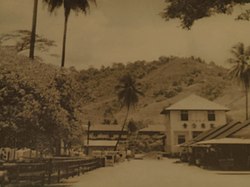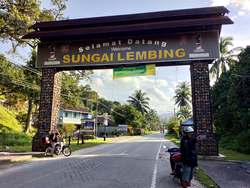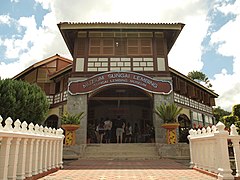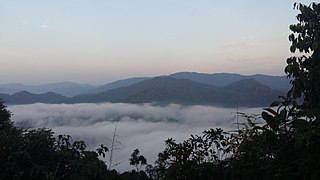Sungai Lembing
Sungai Lembing is a small town in Kuantan District, Pahang, Malaysia. It is about 42 km northwest of Kuantan.[6] The town began in 1900s as tin-mining community when British-based Pahang Consolidated Company Limited (PCCL) setting up the tin mining industry after mining activity begins in 1886. Sungai Lembing had roads, electricity, bungalows, schools, office building, warehouse, shops, cinema, petrol station and a hospital.
Sungai Lembing | |
|---|---|
| Other transcription(s) | |
| • Jawi | سوڠاي لمبيڠ |
| • Chinese | 双溪林明 (Simplified) 雙溪林明 (Traditional) |
| • Japanese | スンガイ・レンビン |
 Sungai Lembing downtown | |
| Etymology: Malay: Sungai Lembing (spear river) | |
| Nickname(s): | |
 Sungai Lembing  Sungai Lembing | |
| Coordinates: 3°55′00.9″N 103°02′05.9″E | |
| Country | |
| State | |
| District | Kuantan District |
| Founded | 1900s[3] |
| Population (2014) | |
| • Total | 5,000[4] |
| Time zone | UTC+08:00 (MST) |
| Postcode | 26200[5] |
| Telephone area code | +6-09 |
Sungai Lembing were affected by 1926 floods which damaged infrastructures in the town and mining activity were suspended for three months. It was later followed by great depression, Japanese occupation of Malaya and Malayan Emergency which greatly affects the tin mining industry in this town. Since independence, Sungai Lembing starts to decline as global demand for tin drops and the price of tin worldwide fell causes the mine to shut down in 1986. By this time, many out-of-work miners and other residents had moved elsewhere and causes some facilities such as shops and petrol station to closed.
After 2001, Sungai Lembing was revitalized as a heritage tourism attraction with opening of Sungai Lembing Museum and subsequent investment from government has made this area one of the important tourist attraction in Pahang and had attracts large numbers of tourists. The great fire of 2019 has raised concern regarding the preservation of historical buildings, through reconstruction of old buildings is ongoing. As of 2014, there are around 5,000 residents who are still living in Sungai Lembing.
Etymology
There are multiple suggestions regarding the origin of the name of this place. One suggested that based on local legend, the local ruler saw a vision of a spear in the nearby river and thus named his town after this vision. Based on English translation, Lembing is Malay for spear, and "sungai" means river. Another origin story suggests that there is an incident where a group of Orang Asli threw spear over the deer, who later escaped by jumping over and disappeared in Sungai Kenau (Kenau river).[7]
Regarding the nickname given to the town as "El Dorado of the East" is because this area is rich in natural resources which will brings wealth to people.[7]
History
Foundation


The tin mining area was the largest and deepest tin mining area in the world during that time, where the tunnel spans around 322 kilometres (200 mi) with the depth between 610 metres (2,000 ft) and 700 metres (2,300 ft).[8] The mining activity begins in 1886 by Pahang Consolidated Company Limited (PCCL) which were headquartered in London[7] and had hired approximately 1,500 miners to mine tin.[9] During its peak, the mine was operated by 5,000 workers who produced 4,000 tons of tin annually.[10] Sungai Lembing town later then developed in the 1900s when the British set up the tin mining industry and provided facilities and amenities to the town such as roads, electricity, bungalows, schools, office building, warehouse, shops, cinema and a hospital, although the electricity usage is limited to 12 hours per day.[3] Imported products sold in this town are duty-free.[1] Non-residences and visitors usually not allowed to enter the town without permission as security checkpoints were setting up in the entrance to the town,[3] while not all types of workers can enter some building as some buildings are restricted to certain types of classes only.[10]
In 1926, Sungai Lembing suffers from flood which damages 14.5 kilometres (9.0 mi) of railway track, a hospital and 250 homes and the mining operation were suspended for three months. The operation were soon affected by great depression where production quota were imposed on the tin production. It was then followed by Japanese occupation of Malaya where many mining equipment were destroyed and European personnel fled the scene. During the postwar period, the tin production were once again affected by Malayan Emergency.[11]
Post independence and decline
In 1979, Pahang Consolidated Company Limited (PCCL) has transferred the ownership of the company from Britain to Malaysian, and hence renamed the company to Pahang Consolidated Public Limited Company (PCPLC). However, as worldwide demand for the tin declined in addition to the falling prices of tin worldwide,[3] hence the mine was temporary shut down in 1986.[7] The closure of mines has caused around 800 miners to become unemployed as the company enters receivership after financial losses. As no parties are interested in taking over the mining activity, the mine was permanently closed on 1987 by Pahang government.[12] The closure of mining area has caused many residents to move out from town to look for better jobs elsewhere and some facilities such as shops and petrol station were forced to shut down, although some shops continued to operate as usual.[3] Prior to 2001, the major economy sector for this area was shifted from mining to agriculture, which shifting to this sector will in fact causes flood to frequently happens than prior to mine closure period.[13]
In December 1988, two years after mine was closed, there are proposals that are made to revive the town and redevelop into tourist attraction area. One suggestion is that the former mining general's bungalow will be converted into either resthouse or museum, which latter converted into known as Sungai Lembing Museum in 2001. Secondly, around 30 former worker's quarters will be converted into chalets in order to mitigate lack of accommodations for visitors. In addition, the existing infrastructure in Sungai Lembing will be improved and a new clinic will be open to residents. The population during that time was 14,000.[14]
Revitalization

The Sungai Lembing museum was opened in 2001 which brings tourism to this town that will also bring revivals and renaissance to this town, hence the town now focused on tourism sector.[13] The museum is a conversion of a former bungalow which were previously inhabited by British mining manager and his family, and the museum exhibits the mining history in Sungai Lembing.[15] The museum is currently managed by Department of Museum Malaysia.[16]
On 27 March 2004, as part of Eighth Malaysian Plan, the government has allocated RM 7 million in improving the town to turn it into major tourist attraction in Pahang. This includes improvement to Sungai Lembing Museum which were visited by 193,000 visitors as of 2004, revival of mining tunnel for tourism purpose, restoration of movie theatre, and upgrading the road that connects town to tin mining area.[17] In addition, on 16 April 2005, another RM 6.3 million was spent on restoring buildings with historic values such as clubhouses, administration buildings, factories and mining tunnels.[18]
Further developments on Sungai Lembing includes an old food court building which was demolished on 17 November 2006 to make way for reconstruction of a new food court[19] which were completed and opened on 27 September 2008.[20] In addition, construction of an arch at the entrance to Sungai Lembing was approved by government on 6 February 2009.[21] Furthermore, additional 3 bridges were constructed in 2012 which would allow villager's access from Kampong Kawah, Kampung Kuala Kenau and Kampung Seberang to Sungai Lembing and the rest of nation.[22]
On 31 August 2019, a great fire burnt several century-old buildings such as 20 shophouses, 11 terrace houses and a library.[23] The fire displaced 53 residents, whom mostly senior citizens.[24] The great fire has prompt Malaysian Institute of Architects (PAM) to strongly advised to upgrade safety measures on historic building in order to be able to preserve the valuable historic buildings from destruction by fire.[25] Four months after the fire, reconstruction of the building at former fire site will take place with budget of RM 10 billion, with advisory from Kyoto University. The budget will also be used to upgrade the existing facilities in Sungai Lembing.[26]
During the COVID-19 pandemic, right after the transition of level of movement control order from partially restrictive conditional MCO to less restrictive relaxed MCO where border crossing is allowed, the tourism in Sungai Lembing starts to booming again, with 80% of stalls in food court are reportedly reopened and some hostels in this area are fully booked. Most of the visitors during that time were arrived by cars instead of buses which typically seen during normal days. Despite this, social distancing and other curfews continued to practice, and mining tunnel and museum will continued to be closed[2] until 16 June 2020.[27]
Geography
Climate
Sungai Lembing's climate is classified as tropical. The rainfall is quite significant in this area throughout the year. This climate is Af according to the Köppen-Geiger climate classification.[28] The temperature here averages 28 °C. In a year, the average rainfall is 120.6 mm. Precipitation is the lowest in February, with an average of 40.7 mm. With an average of 347.4 mm, the most precipitation falls in December. At an average temperature of 29 °C, May is the hottest month of the year. January and December have the lowest average temperature of the year. It is 26 °C. Between the driest and wettest months, the difference in precipitation is 306.7 mm.[29]
| Climate data for Sungai Lembing | |||||||||||||
|---|---|---|---|---|---|---|---|---|---|---|---|---|---|
| Month | Jan | Feb | Mar | Apr | May | Jun | Jul | Aug | Sep | Oct | Nov | Dec | Year |
| Average high °C (°F) | 30 (86) |
31 (88) |
32 (90) |
33 (91) |
33 (91) |
33 (91) |
33 (91) |
33 (91) |
33 (91) |
32 (90) |
31 (88) |
30 (86) |
33 (91) |
| Daily mean °C (°F) | 26 (79) |
27 (81) |
28 (82) |
28 (82) |
29 (84) |
28 (82) |
28 (82) |
28 (82) |
28 (82) |
28 (82) |
27 (81) |
26 (79) |
28 (82) |
| Average low °C (°F) | 23 (73) |
23 (73) |
23 (73) |
24 (75) |
24 (75) |
24 (75) |
24 (75) |
24 (75) |
23 (73) |
23 (73) |
23 (73) |
23 (73) |
23 (73) |
| Average precipitation mm (inches) | 126 (5.0) |
40.7 (1.60) |
68 (2.7) |
57.7 (2.27) |
89.6 (3.53) |
70.3 (2.77) |
76.5 (3.01) |
103.2 (4.06) |
105.2 (4.14) |
167.8 (6.61) |
194.7 (7.67) |
347.4 (13.68) |
120.6 (4.75) |
| Average relative humidity (%) | 87 | 84 | 84 | 84 | 84 | 84 | 84 | 84 | 84 | 86 | 89 | 89 | 85 |
| Source: timeanddate.com[29] | |||||||||||||
Environmental issues
Since the 1990s, there is a report of slight increase of frequency of floods in this area due to changes in land-uses in river basin area especially agriculture which causes water and soil disequilibrium, which could results in imbalances among water cycle and further exacerbated by weaknesses in urban drainage system that will brings floods in this area.[13] The flood also causes the only road that connects between Sungai Lembing and the rest of Malaysia to being cut off on 2012[30] and on 2014.[4]
The materials from abandoned mines were found to be potentially polluting the rivers and groundwater which it's harmful materials such as arsenic, iron, copper, lead, manganese, nickel and zinc can contaminate the water which will exceeding the water quality level in the stream which has raised concern among environmentalists.[31]
Since 2014, much of the rainforest surrounding the popular Rainbow Waterfall has been cleared to make way for a palm oil plantation.[32] The deforestation also caused the water inside the river nearby to become polluted and affecting the villagers life who relied on river for fresh waters.[33] This issue causes Pahang Department of Environment to issue multiple fines to Mentiga Corporation who are involved in deforestation that causes water pollution in 2018.[34]
Tourism
Sungai Lembing has been designated as tourism area in Pahang since 2004 with massive investment from government.[17] As of July 2017, locals estimated that around 2,000 to 3,000 tourists visited Sungai Lembing on every weekend, and the number will peak when there will be school holiday in both Malaysia and Singapore.[35]
Among the notable tourist attraction in this area are Sungai Lembing Museum and mining tunnel which were known for the tin mining history; crystal museum dedicated to crystals;[36] natural attraction including hot spring, Panorama Hill[37] and Rainbow Waterfall;[1] place of worship including Gua Charas where the Buddhist and Hindu temple were located inside the cave.[38]
 Sungai Lembing Museum
Sungai Lembing Museum- Kolong Pahat bridge
 Panorama Hill
Panorama Hill Gua Charas
Gua Charas
Education
The town is home to several primary schools such as SK Sungai Lembing[39] and SJK (C) Lembing,[40] and a high school, SMK Sungai Lembing.[41]
Notable people
Hee Lian
Hee Lian (born 11 August 1910) is known as by far the first possibility known centenarian in Malaysia. She has garnered media attention in 2015 when she attended a hospital on 14 November 2014 to perform surgery on her due to femur fracture and was discharged on 21 November 2014. She was a housewife who lives in Sungai Lembing as her hometown where she used to tend to her vegetable farm and poultry farm. Her husband died at the age of 60 in 1960. She had seven children and two daughters.[42]
In popular culture
- A Malaysian-Singaporean co-produced drama, Kampong Ties is set in Sungai Lembing during 1960s and 1970s.[43]
- Pontianak Harum Sundal Malam 2, a Malaysian horror film, was filmed in Sungai Lembing in November 2004.[44]
References
- Han Sean, Ong (2014-03-20). "Sungai Lembing's evolution from a tin-mining hub to a tourist destination". The Star. Retrieved 2020-07-04.
- "陆续迎来访客 林明山镇 民宿客满" [Locals of Sungai Lembing continues to invite visitors, hotels are fully booked]. China Press (in Chinese). 2020-06-27. Retrieved 2020-07-04.
- Osman, Zulkepli (2019-08-11). "The glory days of Sg Lembing". New Straits Times. Retrieved 2020-07-04.
- BERNAMA (2014-11-24). "Lebih 5,000 penduduk Sungai Lembing terputus hubungan" [More than 5,000 Sungai Lembing residents ends up cut off access to outside world]. Berita Harian (in Malay). Retrieved 2020-07-04.
- "Sungai Lembing, Pahang Postcode List". Postcode.my. Retrieved 2020-07-04.
- Wahida Kamaruzaman, Norul; Zulkiple, Adnan; Awang, Sharifah; Muhammad, Nurmunira (November 2014). "THE PARAMETRIC STUDY ON THE ORIGIN-DESTINATION SURVEY OF RAPID KUANTAN'S USER ALONG SUNGAI LEMBING ROUTE, PAHANG". Conference: 9th Malaysian Road Conference: 1. doi:10.13140/2.1.1395.6805. Retrieved 2020-07-07.
- bt Hussiin, Dr Hasnah (2018-02-14). "SUNGAI LEMBING KINI ASET PELANCONGAN NEGERI PAHANG" [Sungai Lembing is now an asset for tourism in Pahang state]. Universiti Malaysia Pahang (in Malay). Pahang. Retrieved 2020-07-05.
- Grele, Dominique (March 2004). 100 Resorts Malaysia: Places With A Heart. Mandaluyong City: Asiatype Inc. p. 171. ISBN 9789710321032.
- Imran Abdullah, Nik (2016-02-29). "A mine of information at affordable prices". New Straits Times. Retrieved 2020-07-04.
- Aziz, Azran (1999-12-07). "From mining heyday to ghost town". New Straits Times. Retrieved 2020-07-08.
- Talib Ahmad, Abu (2016). "Pahang State History: A Review of the Published Literature and Existing Gaps" (PDF). KEMANUSIAAN. 23 (1): 35–64. Retrieved 2020-07-06.
- "Sungai Lembing on the move". New Straits Times. 1990-02-03. Retrieved 2020-07-08.
- Mohamad, Sulong; Md Hashim, Noorazuan; Aiyub, Kadaruddin; Toriman, M.E. (2012). "Flash Flood and Community's Response at Sg. Lembing, Pahang" (PDF). Advances in Natural and Applied Sciences. 6 (1): 19–25. Retrieved 2020-07-05.
- "Sungai Lembing gets new identity and future". New Straits Times. 1988-12-20. Retrieved 2020-07-08.
- Neo, Michelle (2019-09-27). "Insider's Kuantan Guide: An Adventure-filled Getaway 1 Hour from Singapore". The TravelIntern. Retrieved 2020-07-05.
- Naizi Husin, Nik (2006-10-27). "Experience of tin-mining era". The Star. Retrieved 2020-07-04.
- "RM7mil to restore Sungai Lembing's old attractions". The Star. 2004-03-27. Retrieved 2020-07-04.
- "Pahang to revive Sg Lembing". The Star. 2005-04-16. Retrieved 2020-07-04.
- Khoo, Simon (2006-11-17). "New hawker centre for Sungai Lembing". The Star. Retrieved 2020-07-04.
- "Ministry seeks to help small villages". The Star. 2008-09-29. Retrieved 2020-07-04.
- "Government approves arch for Sungei Lembing". The Star. 2009-02-06. Retrieved 2020-07-04.
- Naizi Husin, Nik (2012-10-04). "Construction of three new bridges in Sungai Lembing going smoothly". The Star. Retrieved 2020-07-04.
- "Elderly couple killed in Sg Lembing fire was preparing for son's wedding". The Star. 2019-08-31. Retrieved 2020-07-04.
- Alagesh, T.N. (2019-09-18). "Sungai Lembing folk miss their iconic landmarks". New Straits Times. Retrieved 2020-07-07.
- Han Sean, Ong (2019-09-07). "PAM: Upgrade safety measures for heritage buildings". The Star. Retrieved 2020-07-04.
- "Housing Ministry allocates RM10m to re-develop Sungai Lembing". Travel Industry Network Media. 2019-12-14. Retrieved 2020-05-07.
- Razak, Aidil (2020-06-11). "Museums to reopen on June 16". New Straits Times. Retrieved 2020-08-10.
- "SUNGAI LEMBING CLIMATE (MALAYSIA)". Climate-Data.org. Retrieved 2020-07-05.
- "Climate & Weather Averages in Sungai Lembing, Malaysia". timeanddate.com. Retrieved 2020-07-05.
- "Floods hit Sungai Lembing town". Citizens Journal. 2012-01-13. Retrieved 2020-07-04.
- Yahya Alshaebi, Fares; Wan Yaacob, Wan Zuhairi; Samsudin, Abdul Rahim; Alsabahi, Esmail (2009). "Risk Assessment at Abandoned Tin Mine In Sungai Lembing, Pahang, Malaysia". Universiti Kebangsaan Malaysia. Retrieved 2020-07-05.
- "伐木严重林明山失色 沈春祥将咨询森林局" [Deforestation damages the bright side of Sungai Lembing, Chun Yang will consult with forestry department regarding this matter]. Nanyang Siang Pau (in Chinese). 2014. Retrieved 2020-07-05.
- de Silva, Joash Ee (2018-05-26). "Logging made water polluted, say villagers". The Star. Retrieved 2020-07-04.
- Fitri Abd Aziz, Mohamad Azim (2018-12-07). "Hulu Sungai Lembing pollution: Logging firm fined RM16,000 for waste disposal offences". New Straits Times. Retrieved 2020-07-04.
- Pek Yee, Foong (2017-07-14). "Ex-mining town embraces ecotourism". The Star. Retrieved 2020-07-04.
- Khoo, Simon (2009-10-21). "Former miner opens crystal museum". The Star. Retrieved 2020-07-04.
- Begum, Faridah (2007-01-01). "Safari-park plan for Sungai Lembing". The Star. Retrieved 2020-07-04.
- Khoo, Simon (2007-01-09). "Unusual sights at Charas Cave". The Star. Retrieved 2020-07-04.
- "Firm donates RM50,000". The Star. 2006-09-18. Retrieved 2020-07-04.
- "Firm gives equipment to Sg Lembing school". The Star. 2006-12-18. Retrieved 2020-07-04.
- "Parents to send students to school". New Straits Times. 1989-03-06. Retrieved 2020-07-08.
- "Hospital successfully operates on centenarian". The Star. 2015-01-26. Retrieved 2020-07-04.
- Soo Wah, Chan (2011-09-27). "Kampong Ties premieres tonight on ntv7". The Sun. Archived from the original on 2011-10-01. Retrieved 2020-07-04.
- Zieman (2004-08-11). "Scarier Pontianak sequel in the works". The Star. Retrieved 2020-07-04.
External links
| Wikimedia Commons has media related to Sungai Lembing. |